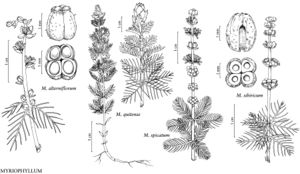Myriophyllum spicatum
Sp. Pl. 2: 992. 1753.
Herbs monoecious, aquatic, often forming dense stands. Stems often much-branched distally, to 6 m. Turions absent. Leaves in whorls of (3 or)4(or 5), heteromorphic; petiole 0–0.4 mm; submersed leaves pectinate, obovate in outline, (14–)18–32(–36) × 10–20(–30) mm, segments (20–)24–36(–42), linear-filiform, longest segment 2–20(–26) mm, usually parallel and all in 1 plane, forming angles less than 45° with central axis; emersed leaves pectinate to pinnatifid proximally, with abrupt transition to obovate or elliptic, sometimes distally spatulate, in outline, margins of distal leaves entire to serrate to shallowly lobed, 1–2.3 × 0.6–1(–1.5) mm. Inflorescences to 15 cm; flowers proximally pistillate, medially bisexual, distally staminate; bracteoles cream to stramineous to purple, with distinct reddish or brown margins, usually ovate to depressed-ovate or obovate, sometimes elliptic to triangular or rhombic, 0.5–0.9 × 0.4–0.7 mm, margins entire or serrate, sometimes with distal, irregular, membranous fringe. Staminate flowers: sepals cream to stramineous, triangular, 0.3–0.4 × 0.2–0.3 mm; petals caducous, cream to red or dark purple, oblong to elliptic or obovate, 1.5–2.5(–3) × 0.8–1 mm; stamens 8, filaments to 1.2 mm, anthers greenish cream to yellow or purple, 1–2.2 × 0.4–0.8 mm. Pistillate flowers: sepals cream to green to purple, lanceolate to deltate or ovate, 0.1–0.3 × 0.1–0.2 mm; petals often persistent, cream, widely ovate, 0.6–0.8 × 0.3–0.4 mm; pistils 0.9–1.2 mm, stigmas white to red to ± purple, 0.2–0.7 mm. Fruits globose, 4-lobed. Mericarps olive-green to brown, cylindric to narrowly ovoid, 1.5–2.2 × 0.8–1.3 mm, transversely widely obovate, abaxial surface broadly rounded, sparsely and irregularly tuberculate, margins smooth to tuberculate, sometimes with 2 shallow, longitudinal ridges, wings and ribs absent. 2n = 42.
Phenology: Flowering and fruiting Apr–Oct.
Habitat: Oligotrophic to eutrophic waters, lakes, ponds, canals, streams.
Elevation: 0–1500 m.
Distribution
Introduced; B.C., N.B., Ont., Que., Ala., Ariz., Ark., Calif., Colo., Conn., Del., D.C., Fla., Ga., Idaho, Ill., Ind., Iowa, Kans., Ky., La., Md., Mass., Mich., Minn., Miss., Mo., Mont., Nebr., Nev., N.H., N.J., N.Y., N.C., N.Dak., Ohio, Okla., Oreg., Pa., R.I., S.C., Tenn., Tex., Utah, Vt., Va., Wash., W.Va., Wis., Eurasia, n Africa.
Discussion
Myriophyllum spicatum is considered one of the worst nuisance aquatic weeds in North America. Identification of this species is critical for management of lakes. Until the early 1900s, the widely accepted view was that M. spicatum was native to North America and was conspecific with European M. spicatum. M. L. Fernald (1919c) described M. exalbescens to distinguish all North American specimens from European M. spicatum, with the former name subsequently being changed to M. sibiricum due to nomenclatural precedence (S. G. Aiken and A. Cronquist 1988). The first to recognize the presence of both species in North America was apparently C. F. Reed (1970b). E. Hultén (1941–1950), B. C. Patten (1954), and S. A. Nichols (1975) proposed alternatively that M. spicatum and the native M. sibiricum form a continuum of variation, suggesting the two taxa may simply represent varieties or subspecies of a highly variable cosmopolitan species. Based on a study of herbarium collections, R. Couch and E. Nelson (1985, 1992) believed that M. spicatum was introduced from Europe in the 1940s and subsequently spread throughout the United States and Canada. A recent biogeographic study of cpDNA haplotypes indicates this species was introduced to North America from China and Korea (M. L. Moody et al. 2016).
Based upon examination of specimens for this treatment, and as pointed out by A. E. Orchard (1981), most of the characters initially proposed by M. L. Fernald (1919c) and expanded upon by S. G. Aiken (1981) that are thought to be reliable for distinguishing the two species, such as size and shape of floral bracts and bracteoles, anther length, swollen base of inflorescence, color of the stem in dried material, extent of branching, and differences in mericarps, break down when a wide range of North American herbarium material is examined. One of the few useful vegetative characters to distinguish these species in the northern regions of North America is that M. sibiricum often produces turions in the latter part of the growing season, whereas M. spicatum does not (E. Hultén 1947). The most commonly used vegetative character to distinguish the two species is the number of leaf segments in submersed leaves (Fernald). When attempting to distinguish plants of the latter two species, this is a reliable character, but only when specimens have low (6–18) or high (24–42) segment numbers; plants often have submersed leaves with intermediate segment numbers.
Molecular studies have shown that the overlap seen in morphological characters, such as leaf segment number, between Myriophyllum sibiricum and M. spicatum may be the result of frequent and widespread hybridization (M. L. Moody and D. H. Les 2002, 2007b; A. P. Sturtevant et al. 2009). Hybrids between these two species can have leaf segment numbers from 16–28 (Moody and Les 2007b), which overlaps with leaf segment numbers for both M. sibiricum (6–18) and M. spicatum (24–36). A reliable method to distinguish these taxa when there is overlap in this character state is DNA fingerprinting (Moody and Les 2002).
Selected References
None.
